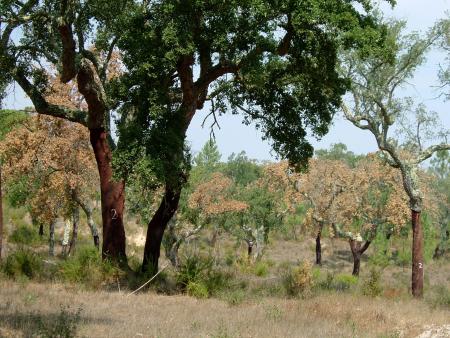
Objective:
It is not possible to separate the cumulative effect of: climate change, soil conditions, cultural practices and the presence of biotic agents, the way the trees die, due to progressive decrepitude or sudden death, as well as the physiological processes involved that are necessarily different and must be treated differently when deciding on the urgency and the period of dead trees felling, the management of the wood material, forestry residues and subsequent options for afforestation, natural regeneration or conversion to another species.
This factsheet aims to highlight some of the pests that cause mortality and the different management of the dead trees according to the biotic agent present.
Context:
Worldwide, there has been an increase in the mortality rate of trees, associated with drought and / or high temperatures, which has been considered by some authors as a way of responding to climate change, namely global warming (1) . The cork oak forests have also witnessed a phenomenon of loss of vitality, with the contribution of several factors like climate change and management practices. The increase in the period of water stress, the best conditions for the development of plagues and diseases and bad cultural practices culminate in the death of the cork oaks.
Contacts:
Conceição Santos Silva, mcssilva@unac.pt, www.unac.pt
Further information:
(1) Allen, C.D.; Macalady, A.K.; Chenchouni, H.; Bachelet, D.; McDowell, N.; Vennetier, M.; Kitzberger, T.; Rigling, A.; Breshears, D.D.; Hogg, E.H.T.; Gonzalez, P.; Fensham, R.; Zheng, Z; Castro, J.; Demidova, N.; Lim, J.; Allard, G.; Running, S.W.; Semerci, A.; Cobb, N.,2009 – A global overview of drought and heat-induced tree mortality reveals emerging climate change risks for forests. Forest Ecology and Management, n.º 259 pp.660-684.
(2) David, T.S.; Pinto, C.A.; Nadezhdina, N.; David, J.S., 2016 – Water and forests in the Mediterranean hot climate zone: a revies based on a hydraulic interpretation of tree functioning. Forest Systems, Vol. 25.Issue 2.eR02. INIA.
(3) Hartmann, H., 2015 – Carbon starvation during drought-induced tree mortality – are we chasing a myth? Journal of plant hydraulics 2: e-005.
(4) Sousa, E.; Santos, M.N.; Varela, M.C.; Henriques, J., 2007 – Perda de vigor dos montados de sobro e azinho: análise da situação e perspectivas. Ed. DGRF e INIAV.